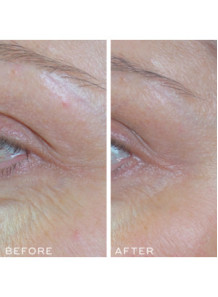Retinyl Retinoate 99%
- Product Code: 8289
Retinal Vitamin A (Vitamin A) (also known as Retinaldehyde) is vitamin A. The most effective that the FDA allows use in cosmetics.
- -
- -
- -
- -
- -
- -
- -
- -
- -
- -
- -
- -
- -
- -
- -
- -
- -
- -
| Test Name | Specification |
|---|---|
| Appearance | Yellow to orange solid |
| Odor | Characteristics |
| Purity (HPLC-DAD) | 95.0% Min |
| Loss on drying (%) | 1.0% Max |
| Residue on ignition | 0.2% Max |
| Aerobic Plate (CFU/ml) | 100CFU/ml Max |
| Yeast & Molds (CFU/ml) | 10CFU/ml Max |
| Escherichia coli | Negative |
| Pseudomonas aeruginosa | Negative |
| Staphylococcus aureus | Negative |
| Heavy Metals | 20ppm Max |
Retinal Vitamin A (Vitamin A) (also known as Retinaldehyde) is vitamin A. The most effective that the FDA allows use in cosmetics. Since it can be converted to Retionic Acid within 1 natural process by the skin (it can convert faster than Retinol, it is more efficient than Retinol).
Vitamin A is currently the only cosmetic ingredient clinically recognized as effective for anti-aging and can reduce skin wrinkles.
Retinal when applied to the skin. Will be converted to Retionic Acid, a vitamin A in the form that the skin is ready to use

Products using Retinal must be packaged in a protective packaging that protects the formula from light, as the retinal deteriorates when exposed to light.
Suggested use ProtecTM OX And ProtecTM UV and ProtecTM SQ Or Bakuchiol * In the formula to help protect Vitamin A from quality deterioration (Click on ProtecTM SQ To examine the research results on the stability of Vitamin A group)
* From the research results " Bakuchiol to Stabilize Retinol and Polyunsaturated Lipids ”by Boxin Ou, PhD, International Chemistry Testing, Milford, MA USA. Bakuchiol At the rate of 2% of the Retinal in the formula
Formulas using Retinal should be oil-in-water only to avoid exposure to retinal air.
In the mixing process Please avoid the heat in the production. If heat is required in the formulation for the mixing process, please add Retinal at the last step. Blend to melt into the recipe. Without exposure to heat
The company sells 4 types of Vitamin A:
1. Retinyl palmitate / Retinol palmitate (liquid) Easy to use, inexpensive, but limited in performance.
2. Retinyl Acetate (powder) Easy to use, inexpensive, but limited in performance.
3. Retinaldehyde (powder) Difficult to use, high price, high efficiency.
4. ActiveRelease Retinal (powder) Easy to use, moderate price, high efficiency.
The results of the experiment on the skin using Retinaldehyde 0.5% for 1 month on the arm surface (forearm).
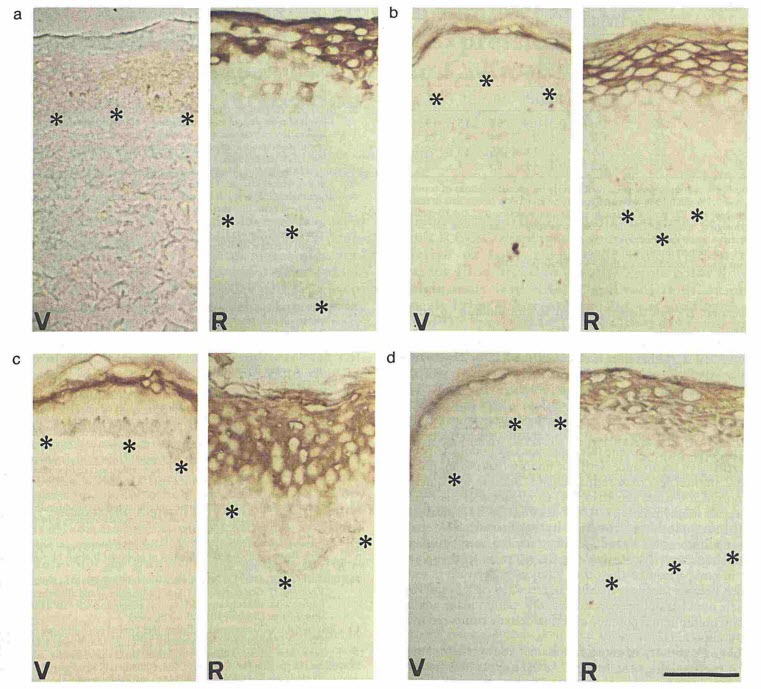
Figure a shows the layers of keratin in the skin where v is vehicle and r is retinaldehyde 0.5% 1 month. The thickening of keratin levels was found.
Picture b Represents the class of transglutaminase in the skin where v is vehicle and r is retinaldehyde 0.5% 1 month. transglutaminase Clearly thickened
Picture c Represents layers of involucrin in the skin where v is vehicle and r is retinaldehyde 0.5% 1 month. involucrin Clearly thickened
Picture d Indicates the filaggrin layer in the skin where v is vehicle and r is retinaldehyde 0.5% 1 month. The level of filaggrin was clearly thicker.
Usage: For anti-wrinkle products in the form of a serum, lotion or cream.
Mixing method: Mix in the oil. Avoid using heat The formula should have a pH in the range of 3.5-6.5, the formula should have ActiveProtecTM OX 1% Always, Should use Vitamin B3 In conjunction with the research found that the use of Vitamin B3 Together with Retinal, the skin is more resistant to retinal irritants, making the retinal more active.
Rate of use: 0.01-0.1% (recommended 0.05%, warning: use of more than 0.1% causes skin irritation. Dangerous)
Product characteristics: Dark red-brown flake powder (Brown-Red Crystal) deteriorates quickly when exposed to UV light. ActiveRelease RetinalTM Instead, which is able to tolerate UV light better
Solubility: Can dissolve in oil
Storage: If you want to keep long-term Keep it frozen or keep in the refrigerator. (If able to freeze Please freeze) Do not expose to light, heat, seal the lid tightly, avoid exposure to air.
INCI Name : A. Retinal
An example of a product that uses retinal as the main component of a formula.
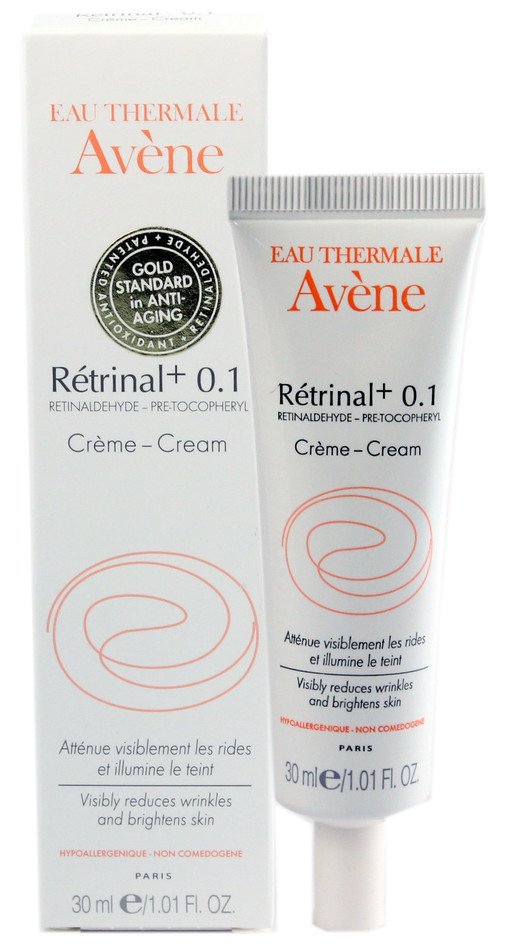
Avene Retrinal Plus 0.1
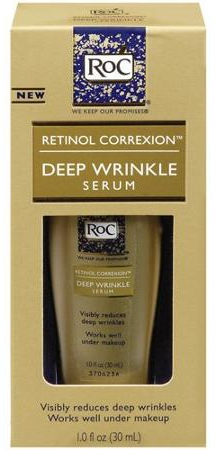
RoC® RETINOL CORREXION®
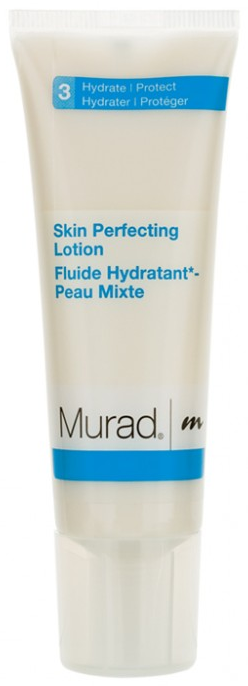
MURAD Skin Perfecting Lotion
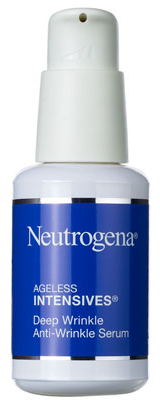
Neutrogena Ageless Intensives Deep Wrinkle Anti-Wrinkle Serum With Retinol
Be the first to review this product :-)
Recent dicussion threads:
- › 2023-06-26 Hydroxypinacolone Retinoate vs. Retinyl Retinoate
Example recipes using this ingredient:
- › lock_outlineNight VitA Test 27/5/2566
Recommend Lab-Service
| Lab Service | Price |
|---|
Retinal Vitamin A (Vitamin A) (also known as Retinaldehyde) is vitamin A. The most effective that the FDA allows use in cosmetics.
Retinal Vitamin A (Vitamin A) (also known as Retinaldehyde) is vitamin A. The most effective that the FDA allows use in cosmetics. Since it can be converted to Retionic Acid within 1 natural process by the skin (it can convert faster than Retinol, it is more efficient than Retinol).
Vitamin A is currently the only cosmetic ingredient clinically recognized as effective for anti-aging and can reduce skin wrinkles.
Retinal when applied to the skin. Will be converted to Retionic Acid, a vitamin A in the form that the skin is ready to use

Products using Retinal must be packaged in a protective packaging that protects the formula from light, as the retinal deteriorates when exposed to light.
Suggested use ProtecTM OX And ProtecTM UV and ProtecTM SQ Or Bakuchiol * In the formula to help protect Vitamin A from quality deterioration (Click on ProtecTM SQ To examine the research results on the stability of Vitamin A group)
* From the research results " Bakuchiol to Stabilize Retinol and Polyunsaturated Lipids ”by Boxin Ou, PhD, International Chemistry Testing, Milford, MA USA. Bakuchiol At the rate of 2% of the Retinal in the formula
Formulas using Retinal should be oil-in-water only to avoid exposure to retinal air.
In the mixing process Please avoid the heat in the production. If heat is required in the formulation for the mixing process, please add Retinal at the last step. Blend to melt into the recipe. Without exposure to heat
The company sells 4 types of Vitamin A:
1. Retinyl palmitate / Retinol palmitate (liquid) Easy to use, inexpensive, but limited in performance.
2. Retinyl Acetate (powder) Easy to use, inexpensive, but limited in performance.
3. Retinaldehyde (powder) Difficult to use, high price, high efficiency.
4. ActiveRelease Retinal (powder) Easy to use, moderate price, high efficiency.
The results of the experiment on the skin using Retinaldehyde 0.5% for 1 month on the arm surface (forearm).

Figure a shows the layers of keratin in the skin where v is vehicle and r is retinaldehyde 0.5% 1 month. The thickening of keratin levels was found.
Picture b Represents the class of transglutaminase in the skin where v is vehicle and r is retinaldehyde 0.5% 1 month. transglutaminase Clearly thickened
Picture c Represents layers of involucrin in the skin where v is vehicle and r is retinaldehyde 0.5% 1 month. involucrin Clearly thickened
Picture d Indicates the filaggrin layer in the skin where v is vehicle and r is retinaldehyde 0.5% 1 month. The level of filaggrin was clearly thicker.
Usage: For anti-wrinkle products in the form of a serum, lotion or cream.
Mixing method: Mix in the oil. Avoid using heat The formula should have a pH in the range of 3.5-6.5, the formula should have ActiveProtecTM OX 1% Always, Should use Vitamin B3 In conjunction with the research found that the use of Vitamin B3 Together with Retinal, the skin is more resistant to retinal irritants, making the retinal more active.
Rate of use: 0.01-0.1% (recommended 0.05%, warning: use of more than 0.1% causes skin irritation. Dangerous)
Product characteristics: Dark red-brown flake powder (Brown-Red Crystal) deteriorates quickly when exposed to UV light. ActiveRelease RetinalTM Instead, which is able to tolerate UV light better
Solubility: Can dissolve in oil
Storage: If you want to keep long-term Keep it frozen or keep in the refrigerator. (If able to freeze Please freeze) Do not expose to light, heat, seal the lid tightly, avoid exposure to air.
INCI Name : A. Retinal
An example of a product that uses retinal as the main component of a formula.

Avene Retrinal Plus 0.1

RoC® RETINOL CORREXION®

MURAD Skin Perfecting Lotion

Neutrogena Ageless Intensives Deep Wrinkle Anti-Wrinkle Serum With Retinol
| Mechanism | - |
| Appearance | - |
| Longevity | - |
| Strength | - |
| Storage | - |
| Shelf Life | - |
| Allergen(s) | - |
| Dosage (Range) | - |
| Recommended Dosage | - |
| Dosage (Per Day) | - |
| Recommended Dosage (Per Day) | - |
| Mix Method | - |
| Heat Resistance | - |
| Stable in pH range | - |
| Solubility | - |
| Product Types | - |
| INCI | - |
Cart
No products



